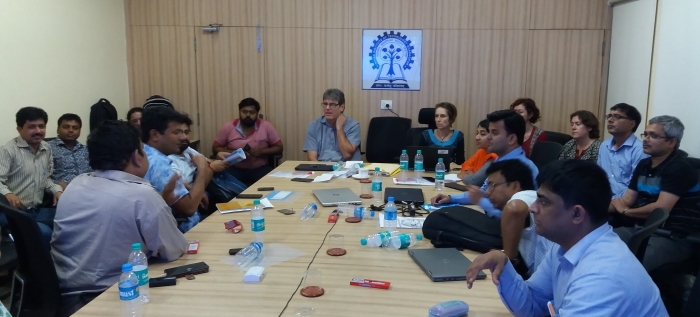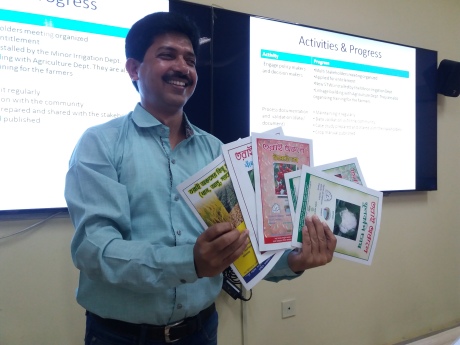Written by: Kazi Farid (Bangladesh Agriculture University) and Niladri Sekhar Bagchi (Indian Institute of Technology)
The SIAGI semester meeting was held at Indian Institute of Technology (IIT) Kharagpur extension campus at Salt Lake, Kolkata from 27th to 29th March 2018. It was a nice gathering of a diverse group of stakeholders including university faculties, researchers, development practitioners, NGO partners, and PhD students from Australia, Bangladesh and India. The main objectives of the meeting were to update and discuss the work progress of each partner of SIAGI project, to present and refine the research proposals by the PhD candidates and to modify future plans according to received feedback.
The meeting started with a briefing by Mr. Arnab Chakraborty, PRADAN, on WBADMIP (West Bengal Accelerated Development and Minor Irrigation Project) workshop on 26th March where ways to converge works of WBADMIP and SIAGI were explored. Dr. Christian Roth, team leader of SIAGI, explained the importance of the works being undertaken by WBADMIP and the role SIAGI can play to fill the gap in their works and complement each other.

Dr. Pulak Mishra from IIT Kharagpur presented about the research activities being done by IIT Kharagpur and CDHI on value chain. He pointed out issues of mismatch between demand and supply, negligence of human capital in the process of focusing more on social capital through ethical community engagement and importance of studying group dynamics and equal focus on quantitative aspects along with qualitative aspects of research. There was an interesting debate on quantitative approach versus qualitative approach and the SIAGI team was liberal enough to accept the complementary roles of the two.
Along with their field activities, BAU team updated about their research progress including Master and PhD research with a thorough presentation by Dr. Hasneen Jahan. She mentioned that one of the Master students has completed his Master degree in December 2017 and wrote thesis on “Rural Livelihood and Social Inclusiveness underAgricultural Intensification”; one is in the field for collecting primary data for her thesis and will complete her degree by June 2018; and another two are developing their research proposals and will complete their Master degree by December 2018.
Mr. Niladri Sekhar Bagchi, PhD scholar from IIT Kharagpur presented the outline of his research proposal on dynamics of agricultural markets. Mr. Mojammel Haque, PhD student from BAU presented his modified proposal on inclusive value chain of sweet water shrimp at Dacope, Khulna. Mr. Kazi Farid, a new PhD candidate from BAU presented his research proposal on developing an integrated model in order to combat social exclusion among the marginalized communities of coastal Bangladesh.The specialty of his proposal is that he’ll completely adopt a qualitative participatory approach to address his research questions. Everyone in the meeting eagerly listened to all the PhD proposals and gave their valuable suggestions.Kazi was delighted for becoming the part of SIAGI team. This meeting was a great opportunity for him. In his words:
“I think I am the luckiest person in this meeting. As a newcomer, it’s a great opportunity for me to know about the SIAGI project, its objectives, current status and future activities. Earlier I had very little knowledge about this project. Now I know a lot about this and it’ll be helpful for me in designing my research objectives” (Kazi mentioned during the closing of the meeting)
Dr. Uday Nidumolu (CSIRO) and Dr. Wendy Merritt’s (ANU) presentations on ‘bio-economic modelling’ and ‘integrated modelling’ were of special interest for the participants. Uday discussed his model as a participatory model in order to examine farmers’ crop choices and showed how this model fits with the field level data. On the other hand, Wendy described the potentials of ‘mental modeller’ and ‘fuzzy cognitive model’ for further reshaping the integrated model. Lucy’s presentation on nutrition sensitive agriculture evoked a lot of enthusiasm from all corners of the round table as higher income does not necessarily lead to better nutrition and health.
The NGO partner, PRADAN, in their presentation narrated their works in the villages of Chaka Doba and Hakim Sinan in Bankura district of West Bengal, where a holistic social, psychological and economic change is aimed for through participation of community. Mr. Subrata Majumdar from CDHI highlighted how the process of ethical community engagement has been playing a catalytic role in the mobilization of farmers’ groups and women SHGs in the villages of Dhaloguri and Uttar Chakowakheti. Shushilan updated on how community engagement process through the ‘water and silt management committees’ at Sekendarkhali and Amtoli, in Bangladesh are working in the project areas and how crop production is increasing because of active participation of local people with SIAGI. The most important thing is that disadvantaged people of both Dacope and Amtoli are now aspiring for new knowledge instead of credit and in-kind support.

Emerging lessons and highlights:
From our perspective the main observations are:
- It was clear from the operation of SIAGI in the last two years that the attitude of people towards development can evolve from a donation-dependent mentality towards a self-dependable and self-sustainable mentality through continuous engagement with the community guided by the principles of ethical community engagement
- It is very important to understand the dynamics of collectives formed in the study villages in order to design proper strategies for the sustainability of the collectives even after the completion of the project.
- The linkage of farmers with the rural as well as nearby urban markets and the embedded risks need to be further studied to mitigate the prospect of demand-supply mismatch. As marketing is a major area of concern among the farmers, development of marketing skills among farmers through provision of training should be explored.
- Earlier there was disagreement whether quantitative methods should have more importance than qualitative methods. Some of the SIAGI team were reluctant to use qualitative approach. But gradually homogeneity in thinking among team members has been established. Now the team members think that qualitative methods are equally important as quantitative methods, in order to carry on research for development of the community and its environment. Both quantitative and qualitative research approaches should be applied in a complementary manner, as any one approach applied separately will bear the danger of misinterpretation of real problems and issues.
- Increased collaboration with a diverse/heterogeneous group of stakeholders is another achievement of the SIAGI project. Through this project we learnt how the members of an interdisciplinary team interact with each other, act accordingly and learn form each other.